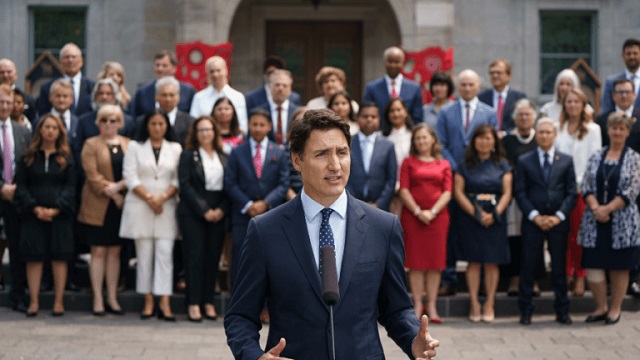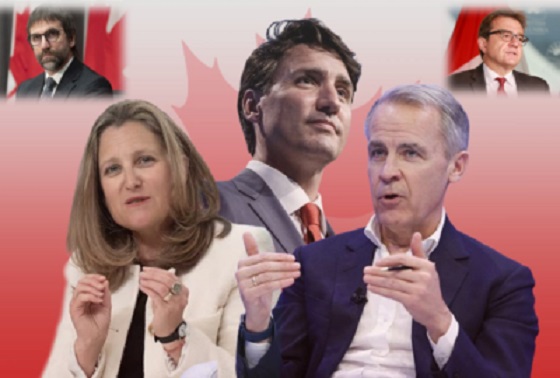National
Liberal Patronage: $330 Million in Questionable Allocations at Canada’s Green Tech Agency

What we learned from the committee is as clear as it is disturbing: Liberal ministers and appointees at SDTC have been funneling taxpayer dollars to friends under the guise of green technology funding.
In a damning House of Commons Public Accounts Committee (PACP) meeting, details emerged that Canada’s flagship “green” agency, Sustainable Development Technology Canada (SDTC), funneled hundreds of millions of taxpayer dollars into companies connected to Liberal insiders. An Auditor General’s report shed light on the staggering scale of this apparent Liberal patronage scheme, revealing that $330 million was awarded to projects with board members tied to the SDTC itself. Another $59 million found its way into initiatives that didn’t even meet SDTC’s green-tech mandate, fueling accusations of political favoritism and cronyism within Prime Minister Trudeau’s government.
Opposition MPs, led by Conservatives Rick Perkins and Michael Cooper, along with Bloc MP Nathalie Sinclair-Desgagné and NDP MP Richard Cannings, took turns dissecting former Liberal Minister Navdeep Bains’ role in appointing Annette Verschuren as SDTC’s board chair. Testimony from the hearing, corroborated by statements from SDTC’s CEO, revealed that Bains reached out to Verschuren multiple times about her appointment, despite his claims of following an “open, transparent, and arm’s-length” process. Yet, when grilled by the opposition, Bains repeatedly invoked “process” and shifted blame onto the Privy Council Office (PCO), claiming he merely encouraged a diverse pool of applicants.
But the evidence doesn’t line up with the former minister’s narrative. Witnesses testified that Assistant Deputy Minister Noseworthy had informed SDTC CEO Leah Lawrence of Verschuren’s appointment even before it was finalized, indicating a behind-the-scenes process driven by Liberal influence. These revelations throw the credibility of the appointment process into question, suggesting it may have been less about selecting qualified candidates and more about ensuring loyal Liberal allies held key positions.
The committee’s findings, sparked by the Auditor General’s investigation, expose a serious issue of conflicts of interest within SDTC’s funding operations. This is a public agency with a mission to advance sustainable development, yet the Liberal government’s management seems to have turned it into a cash machine for insiders. The Auditor General’s report has revealed a troubling pattern of funding allocations going to companies with board connections, undercutting the government’s credibility on environmental stewardship and transparency.
What we learned from the committee is as clear as it is disturbing: Liberal ministers and appointees at SDTC have been funneling taxpayer dollars to friends under the guise of green technology funding. This isn’t just a lapse in oversight; it’s a systematic approach that prioritizes insider deals over real environmental progress, putting the Trudeau government’s commitment to transparency and sustainability squarely in doubt.
Opposition MPs Call Out Lack of Accountability
During this pivotal Public Accounts Committee meeting, opposition MPs went on the offensive, exposing a deep pattern of evasion and mismanagement in how taxpayer dollars were funneled into the hands of Liberal insiders under former Liberal Minister Navdeep Bains. Conservative MPs Rick Perkins and Michael Cooper led the charge, calling out Bains’ deflections and demanding straight answers. They pointed to the $330 million awarded by Sustainable Development Technology Canada (SDTC) to projects connected to its own board members, questioning why this blatant conflict of interest was permitted under Bains’ watch.
Perkins and Cooper’s approach was blunt. They challenged Bains on his repeated reliance on vague, bureaucratic defenses, pointing out that as minister, he had a duty to exercise oversight on SDTC’s operations. Perkins in particular questioned Bains about his involvement in appointing Annette Verschuren as chair of SDTC’s board. Despite Bains’ claims that he couldn’t “recall” specific discussions with Verschuren, evidence surfaced that he contacted her multiple times prior to her appointment. For Perkins and Cooper, this level of involvement, coupled with Bains’ repeated refusal to acknowledge conflicts of interest within SDTC, painted a damning picture of a Liberal minister who prioritized insider appointments over accountability to Canadian taxpayers.
Bloc MP Nathalie Sinclair-Desgagné and NDP MP Richard Cannings focused their questioning on the government’s failure to ensure responsible oversight of SDTC’s environmental funds. Sinclair-Desgagné highlighted Bains’ “arm’s-length” defense as an excuse, given the testimony indicating that senior officials had preemptively informed SDTC’s CEO about Verschuren’s appointment, suggesting an internal network of influence rather than a transparent, merit-based process. She called out the apparent detachment of Bains from SDTC’s operations, underscoring how his office either ignored or bypassed red flags.
NDP MP Cannings raised critical points about the hypocrisy of a government that claims to champion green innovation while allowing SDTC to devolve into a taxpayer-funded favor bank. Cannings pointed out that SDTC’s funds, meant for real environmental progress, were instead granted to projects with questionable ties and little sustainability impact. For Canadians concerned with climate action, Cannings’ questions laid bare the truth: the Liberal government’s commitment to “green” initiatives is far weaker than their dedication to keeping insiders funded.
This unified front by Conservative, Bloc, and NDP MPs highlighted the same disturbing trend: a Liberal government that talks about accountability and climate action but delivers neither, choosing instead to use taxpayer funds to benefit those closest to the party.
Bains’ Defense: Hiding Behind “Process” and Arm’s-Length Excuses
When faced with tough questions on SDTC’s mismanagement, former Liberal Minister Navdeep Bains clung tightly to procedural defenses, repeatedly deflecting responsibility to the Privy Council Office (PCO) and downplaying his role as minister. Bains insisted that the PCO alone was responsible for vetting board members, suggesting his involvement was “hands-off” and strictly procedural. Yet, opposition MPs saw right through this tactic, viewing it as a clear attempt to dodge accountability.
Throughout the hearing, Bains deflected pointed questions by portraying SDTC’s oversight as out of his hands, claiming his office only followed standard processes. He avoided addressing why his appointee, Annette Verschuren, landed the SDTC board chair role despite potential conflicts of interest, with millions later flowing to companies linked to board members. By painting himself as a mere bystander to PCO’s vetting process, Bains sidestepped responsibility for ensuring taxpayer funds went to projects with genuine environmental merit, rather than those benefiting Liberal insiders.
When pressed about specific discussions surrounding Verschuren’s appointment, Bains leaned on what can only be described as selective memory. Asked about his personal involvement, he claimed he “couldn’t recall” multiple key conversations — a response that only raised eyebrows among committee members. Testimonies from SDTC’s CEO and other witnesses indicated Bains contacted Verschuren several times, yet his failure to acknowledge this directly cast doubt on his narrative of impartial oversight.
Opposition MPs argued that Bains’ procedural evasions were thinly veiled attempts to cover for what looks like a Liberal patronage pipeline. His refusal to answer clearly and his dependence on “I don’t recall” responses drew sharp criticism, with opposition leaders labeling it as a standard Liberal tactic to avoid admitting responsibility. The result? A testimony that shed little light on how SDTC was run but spoke volumes about the government’s willingness to dodge accountability whenever insiders are involved.
Inclusion and “Transparency” Won’t Save Liberals from Accountability
Throughout the Public Accounts Committee hearing, Liberal MPs Jean Yip and Francis Drouin took on a clear mission: protect Navdeep Bains at all costs. Instead of addressing the mountain of allegations around SDTC’s blatant cronyism and taxpayer waste, Yip and Drouin turned the hearing into a platform for Liberal talking points, spinning tales of “transparency” and “diversity” that conveniently dodged the actual corruption in front of them. Let’s be clear: hiding behind “inclusivity” doesn’t make the Liberals less corrupt, nor does it absolve them of responsibility when taxpayer money is at stake.
Jean Yip’s questioning gave Bains endless opportunities to recite the “open and competitive” process that supposedly led to Annette Verschuren’s appointment as SDTC board chair. Yet she never asked about Verschuren’s Liberal ties, or why so many millions were awarded to companies connected to SDTC board members. Yip’s focus on “inclusion” and “diverse voices” on the board was a distraction — a slick attempt to shift attention away from the Auditor General’s findings and avoid the reality that those “diverse voices” are well-connected Liberal insiders benefiting from your money.
Francis Drouin was right there to keep the narrative going, pivoting to SDTC’s supposed “green mandate” and giving Bains a platform to tout his government’s commitment to sustainability. But let’s call it what it is: a cover. By talking up sustainability and diversity, Drouin helped Bains avoid explaining why SDTC mismanaged $330 million on projects tied to its own board members, and why an additional $59 million went to ineligible initiatives. This wasn’t accountability — it was damage control, plain and simple.
Yip and Drouin’s interventions were textbook Liberal tactics: deflect, divert, and dilute the discussion. They may have repeated “transparency” and “inclusivity” all they wanted, but these buzzwords are nothing more than a smokescreen for taxpayer-funded favoritism. For Canadians watching, it was an unmistakable display of damage control — the Liberals doing everything they can to dodge real accountability while your tax dollars keep flowing to their inner circle.
Broader Implications: A Systemic Liberal Culture of Avoiding Accountability
The revelations from this Public Accounts Committee meeting show us something far darker than the mismanagement of a single agency. They expose a deeply entrenched system where Trudeau’s Liberal government doesn’t just waste taxpayer money — they use it to reward political cronies and shield insiders from accountability. This isn’t just negligence; it’s the Trudeau Swamp in action, a well-oiled machine funneling your money to friends and allies under the thin cover of bureaucratic “process.”
At the center of this scandal is a strategy the Liberals have perfected: hide behind procedural jargon and “arm’s-length” defenses to dodge any responsibility. The moment former Minister Navdeep Bains took the stand, you could see the tactics at work. Facing questions on how Sustainable Development Technology Canada (SDTC) turned into a cash cow for Liberal insiders, Bains and his fellow Liberal MPs defaulted to the same tired script — insisting every questionable allocation, every insider appointment, was just “routine process.” They claim “independence,” they claim “transparency,” but the evidence paints a different picture: Liberal insiders filling key roles and pulling the strings to channel your money into their pockets.
This scandal isn’t an isolated incident. It’s a glimpse into a troubling pattern, where taxpayer funds — meant for genuine public service — have become Trudeau’s political currency, up for grabs to those with the right connections. And make no mistake: Navdeep Bains’ refusal to answer real questions isn’t just about protecting himself. It’s about preserving a whole Liberal network that thrives on government patronage, hidden behind bureaucratic red tape. The Liberals have turned “process” into a shield, protecting ministers from facing the consequences of their actions.
The stakes couldn’t be higher for Canadians. This isn’t just about misusing a few dollars — it’s about a government prioritizing loyalty over public good, rewarding insiders while millions of Canadians wonder where their taxes are actually going. Under Trudeau’s watch, the promise of accountability has become a punchline, replaced with cronyism and evasion. So here’s the real question: Is Canada governed for its citizens, or for an elite network of well-connected Liberal insiders? Because after this committee meeting, the answer seems painfully clear.
Business
Canadian Police Raid Sophisticated Vancouver Fentanyl Labs, But Insist Millions of Pills Not Destined for U.S.

 Sam Cooper
Sam Cooper
Mounties say labs outfitted with high-grade chemistry equipment and a trained chemist reveal transnational crime groups are advancing in technical sophistication and drug production capacity
Amid a growing trade war between Washington and Beijing, Canada—targeted alongside Mexico and China for special tariffs related to Chinese fentanyl supply chains—has dismantled a sophisticated network of fentanyl labs across British Columbia and arrested an academic lab chemist, the RCMP said Thursday.
At a press conference in Vancouver, senior investigators stood behind seized lab equipment and fentanyl supplies, telling reporters the operation had prevented millions of potentially lethal pills from reaching the streets.
“This interdiction has prevented several million potentially lethal doses of fentanyl from being produced and distributed across Canada,” said Cpl. Arash Seyed. But the presence of commercial-grade laboratory equipment at each of the sites—paired with the arrest of a suspect believed to have formal training in chemistry—signals an evolution in the capabilities of organized crime networks, with “progressively enhanced scientific and technical expertise among transnational organized crime groups involved in the production and distribution of illicit drugs,” Seyed added.
This investigation is ongoing, while the seized drugs, precursor chemicals, and other evidence continue to be processed, police said.
Recent Canadian data confirms the country has become an exporter of fentanyl, and experts identify British Columbia as the epicenter of clandestine labs supplied by Chinese precursors and linked to Mexican cartel distributors upstream.
In a statement that appears politically responsive to the evolving Trump trade threats, Assistant Commissioner David Teboul said, “There continues to be no evidence, in this case and others, that these labs are producing fentanyl for exportation into the United States.”
In late March, during coordinated raids across the suburban municipalities of Pitt Meadows, Mission, Aldergrove, Langley, and Richmond, investigators took down three clandestine fentanyl production sites.
The labs were described by the RCMP as “equipped with specialized chemical processing equipment often found in academic and professional research facilities.” Photos released by authorities show stainless steel reaction vessels, industrial filters, and what appear to be commercial-scale tablet presses and drying trays—pointing to mass production capabilities.
The takedown comes as Canada finds itself in the crosshairs of intensifying geopolitical tension.
Fentanyl remains the leading cause of drug-related deaths in Canada, with toxic supply chains increasingly linked to hybrid transnational networks involving Chinese chemical brokers and domestic Canadian producers.
RCMP said the sprawling B.C. lab probe was launched in the summer of 2023, with teams initiating an investigation into the importation of unregulated chemicals and commercial laboratory equipment that could be used for synthesizing illicit drugs including fentanyl, MDMA, and GHB.
The Bureau is a reader-supported publication.
To receive new posts and support my work, consider becoming a free or paid subscriber.
Invite your friends and earn rewards
2025 Federal Election
Carney needs to cancel gun ban and buyback

 Gage Haubrich
Gage Haubrich
The Canadian Taxpayers Federation is calling on Liberal Leader Mark Carney to stop the gun ban and buyback after he announced he would continue with the scheme.
“Carney needs to scrap this plan and stop wasting taxpayer’s money on it,” said Gage Haubrich, CTF Prairie Director. “Planning to spend potentially billions of dollars on a program that is not going to make Canadians safer is a waste of money.
“Carney needs to be cancelling this wasteful plan, not doubling down on it.”
Conservative Leader Pierre Poilievre is promising to get rid of Ottawa’s gun bans.
The government said the buyback would cost taxpayers $200 million in 2019. Only buying back the guns could cost up to $756 million, according to the Parliamentary Budget Officer. Government documents show that the buyback is now likely to cost almost $2 billion.
The banned gun list includes more than 2,000 different types of firearms.
Every year since the gun ban was announced in 2020, violent gun crime in Canada has increased.
New Zealand conducted a similar, but more extensive, gun ban and buyback in 2019. New Zealand had 1,216 violent firearm offenses in 2023. That’s 349 more offences than the year before the buyback.
Experts also agree that the buyback won’t make Canadians any safer.
The National Police Federation, the union representing the RCMP, says Ottawa’s buyback “diverts extremely important personnel, resources, and funding away from addressing the more immediate and growing threat of criminal use of illegal firearms.”
“Buyback programs are largely ineffective at reducing gun violence, in large part because the people who participate in such programs are not likely to use those guns to commit violence,” said University of Toronto professor Jooyoung Lee
“Experts say that this gun ban and buyback won’t do anything to make Canadians safer,” Haubrich said. “Carney needs to listen to the experts and commit to cancelling this scheme before it costs taxpayers any more money.”
-

 2025 Federal Election1 day ago
2025 Federal Election1 day agoRCMP memo warns of Chinese interference on Canadian university campuses to affect election
-

 2025 Federal Election2 days ago
2025 Federal Election2 days agoConservative Party urges investigation into Carney plan to spend $1 billion on heat pumps
-

 Alberta2 days ago
Alberta2 days agoAlberta takes big step towards shorter wait times and higher quality health care
-

 2025 Federal Election2 days ago
2025 Federal Election2 days agoFifty Shades of Mark Carney
-

 2025 Federal Election15 hours ago
2025 Federal Election15 hours agoResearchers Link China’s Intelligence and Elite Influence Arms to B.C. Government, Liberal Party, and Trudeau-Appointed Senator
-

 2025 Federal Election2 days ago
2025 Federal Election2 days agoCorporate Media Isn’t Reporting on Foreign Interference—It’s Covering for It
-

 Business1 day ago
Business1 day agoTrump raises China tariffs to 125%, announces 90-day pause for countries who’ve reached out to negotiate
-

 2025 Federal Election1 day ago
2025 Federal Election1 day agoThe status quo in Canadian politics isn’t sustainable for national unity








